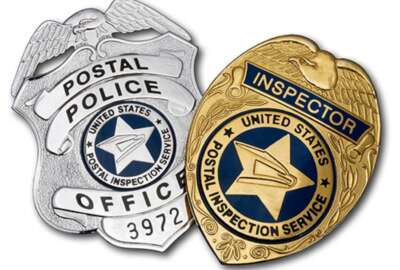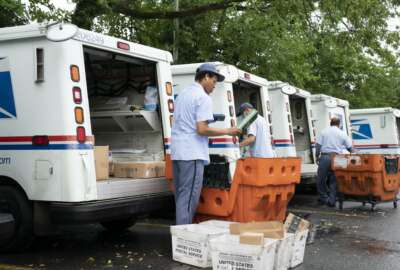Hubbard Radio Washington DC, LLC. All rights reserved. This website is not intended for users located within the European Economic Area.
USPS law enforcement staffing issues pose challenge for mail theft cases, IG finds
The Postal Service is seeing a surge in mail thefts and letter carrier robberies. But the agency’s watchdog office finds the agency and its law enforcement br...
The Postal Service is seeing a surge in mail thefts and letter carrier robberies.
But the agency’s watchdog office finds the agency and its law enforcement branch, the Postal Inspection Service, aren’t making full use of their resources to address postal crime.
As a result, the USPS Office of Inspector General found recent efforts to crack down on mail theft have led to few arrests.
The USPS OIG, in a recent report, found USPIS staffing issues have led to some challenges in handling an increase in mail theft cases. The IG’s office also found that postal inspectors who solely worked mail theft cases are not required to complete specialized mail theft training.
USPIS, according to the IG’s office, has yet to complete a comprehensive strategy to deal with mail theft, and it may take nearly a year to complete.
USPS OIG recommends USPIS develop the plan as soon as possible to “strategically address the reported uptick in mail theft incidents occurring around the nation.”
“Without a finalized mail theft strategy to include agency staffing and analytics metrics to align with that strategy and assess its effectiveness, the Postal Inspection Service risks not having a comprehensive and timely approach to addressing mail theft,” USPS OIG wrote in its report.
USPS and USPIS management, however, disagreed with more than half of the OIG’s recommendations.
In a joint response, USPS and USPIS executives said they already have a mail theft strategy in place, and that a new strategy will be ready by September 2024. They also said postal inspectors receive the training they need to combat a rise in mail theft.
In terms of staffing, USPS and USPIS officials said they are “continuously monitoring and analyzing staffing and attrition,” to ensure they have enough postal inspectors to cover their workload.
“The chief postal inspector and executive committee regularly reassess agency needs to respond to and combat a multitude of postal crimes,” they wrote in response to the USPS OIG’s findings.
Chief Postal Inspector Gary Barksdale, Chief Technology Officer and Executive Vice President Scott Bombaugh, and Chief Retail and Delivery Officer and Executive Vice President Joshua Colin responded in a joint statement to the USPS OIG’s findings.
Frank Albergo, national president of the Postal Police Officers Association, called the report’s findings “a complete indictment of the Postal Inspection Service,” since USPIS has known about a rise in mail theft for about three years.
“This is what happens if you don’t investigate crime and you don’t deter crime. What’s happening is exactly what you would expect to happen. You would expect an explosion of postal-related street crime, and that’s what they got,” Albergo said.
From March 2020 to February 2021, USPIS received nearly 300,000 mail theft complaints, a more than 160% increase compared to the same period a year prior.
USPS is also reporting an increase in mail theft from blue collection boxes across the country. The agency saw more than 38,500 incidents in FY 2022 — an 87% increase compared to mail theft incidents in 2019.
More than 400 on-duty letter carriers were robbed in fiscal 2022. USPS said in May that another 300 letter carriers had been robbed on their routes at that point in fiscal 2023.
USPIS, based on public data from its year-end reports to Congress, has seen a 49% decrease in mail theft arrests between FY 2018 and 2022, and a 43% decrease in mail theft convictions over the same period.
The IG report found USPIS faces staffing challenges, and has “not assessed and assigned personnel resources nationally to address this issue.”
The watchdog also found that “postal inspectors do not receive specialized training in the investigation of mail theft.”
USPIS is operating at 88% of its authorized staffing level. In April 2023, it had 1,208 active postal inspectors and 348 active postal police officers who secure Postal Service facilities.
In an OIG survey of USPIS staff who worked on mail theft cases from FY 2021-2022, about 38% of employees reported a challenge in the availability of staff to work mail theft cases.
“For example, one respondent stated he was not able to dedicate sufficient time to an investigation due to the volume of mail theft complaints and the lack of staff available to investigate them,” the report states.
The IG’s office finds only 37% of postal inspectors worked on mail theft cases last year.
Postal Inspection Service officials stated that although postal inspectors are assigned to specific program areas, they frequently work multiple program area cases.
“Postal inspectors are expected to assist with specific investigations and respond to emergent incidents — including mail theft and robbery incidents — when needed, regardless of their program assignments,” the OIG report states.
Postal Inspection Service headquarters officials told the USPS OIG that they do not address staffing for specific program areas, because leadership at the division level has the flexibility to assign postal inspectors to any team within their respective division based on need.
“We believe it is essential for the Postal Inspection Service to assess workforce planning nationally to determine if the Postal Inspection Service has sufficient staffing to achieve its goals,” USPS OIG wrote.
USPS and the Postal Police Officers Association (PPOA) have been locked in a protracted legal battle for years to determine what jurisdiction postal police officers have beyond USPS facilities.
PPOA filed a federal lawsuit in March calling on USPS to comply with a third-party arbitrator’s recent decision to throw out an August 2020 memo, which limited postal police to only carry out their duties on USPS property.
PPOA said the headcount of postal police officers has decreased by 66% since 2002.
“They made a colossal mistake when they benched the postal police force, and they refuse to admit it,” Albergo said.
Postmaster General Louis DeJoy, in an exclusive interview in July, said USPS doesn’t have the law enforcement resources – or the authority – to deploy postal police officers alongside letter carriers in high-crime areas.
“Expanding our police force to go walk with the carriers, it’s just not something I see as viable,” DeJoy said. “We don’t have the authority to just go out and patrol and arrest people.”
DeJoy suggested that letter carriers, in some cases, should be able to refuse to deliver mail in situations where they are in immediate danger. USPS states on its website that it may suspend delivery service “when there is an immediate threat (including, but not limited to, threats due to loose animals) to the delivery employee, mail security, or postal property.”
“I can’t police the country, and it’s not our job to police the country,” DeJoy said. “An alternative, if crime is really bad in areas, is not to deliver, right? That’s how you keep people safe. Well, how about if we did something like that?”
Earlier this year, USPS’s law enforcement division, the Postal Inspection Service, sent a surge of postal inspectors to investigate mail theft hotspots in Oakland and Chicago.
But they only made a total of three arrests between May and June, and recovered about 270 pieces of stolen mail. Criminals are targeting the mail to steal checks.
USPIS officials told the IG’s office that the surge operations were a success, “as the influx in personnel helped to advance mail theft and robbery activities.”
However, Albergo said surging postal inspectors to high-crime areas will only have a temporary effect.
“When you flood an area with postal inspectors, and then pull them out, their absence is noticed,” Albergo said. “Mail theft is still going crazy in Chicago. Letter carriers are still being robbed in Chicago.”
Copyright © 2024 Federal News Network. All rights reserved. This website is not intended for users located within the European Economic Area.
Jory Heckman
Jory Heckman is a reporter at Federal News Network covering U.S. Postal Service, IRS, big data and technology issues.
Follow @jheckmanWFED





